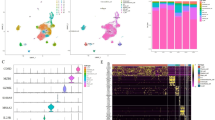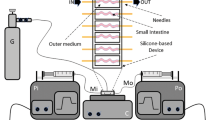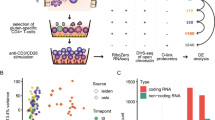Abstract
Celiac disease (CD) is an immune mediated, polygenic disorder, where HLA-DQ2/DQ8 alleles contribute around 35% to genetic risk, but several other genes are also involved. Genome-wide association studies (GWASs) and the more recent immunochip genotyping projects have fine-mapped 39 regions of genetic susceptibility to the disease, most of which harbor candidate genes that could participate in this disease process. We focused our attention to the GWAS peak on chr6: 127.99–128.38 Mb, a region including two genes, thymocyte-expressed molecule involved in selection (THEMIS) and protein tyrosine phosphatase, receptor type, kappa (PTPRK), both of which have immune-related functions. The aim of this work was to evaluate the expression levels of these two genes in duodenal mucosa of active and treated CD patients and in controls, and to determine whether SNPs (rs802734, rs55743914, rs72975916, rs10484718 and rs9491896) associated with CD have any influence on gene expression. THEMIS showed higher expression in active CD compared with treated patients and controls, whereas PTPRK showed lower expression. Our study confirmed the association of this region with CD in our population, but only the genotype of rs802734 showed some influence in the expression of THEMIS. On the other hand, we found a significant positive correlation between THEMIS and PTPRK mRNA levels in CD patients but not in controls. Our results suggest a possible role for both candidate genes in CD pathogenesis and the existence of complex, regulatory relationships that reside in the vast non-coding, functional intergenic regions of the genome. Further investigation is needed to clarify the impact of the disease-associated SNPs on gene function.
Similar content being viewed by others
Log in or create a free account to read this content
Gain free access to this article, as well as selected content from this journal and more on nature.com
or
References
Abadie V, Sollid LM, Barreiro LB, Jabri B : Integration of genetic and immunological insights into a model of celiac disease pathogenesis. Annu Rev Immunol 2011; 29: 493–525.
Dubois PC, Trynka G, Franke L et al: Multiple common variants for celiac disease influencing immune gene expression. Nat Genet 2010; 42: 295–302.
van Heel DA, Franke L, Hunt KA et al: A genome-wide association study for celiac disease identifies risk variants in the region harboring IL2 and IL21. Nat Genet 2007; 39: 827–829.
Trynka G, Hunt KA, Bockett NA et al: Dense genotyping identifies and localizes multiple common and rare variant association signals in celiac disease. Nat Genet 2011; 43: 1193–1201.
Lesourne R, Uehara S, Lee J et al: Themis, a new T cell specific protein important for late thymocyte development. Nat Immunol 2009; 10: 840–847.
Fu G, Vallée S, Rybakin V et al: Themis controls thymocyte selection through modulation of T cell antigen receptor-mediated signalling. Nat Immunol 2009; 10: 848–856.
Brockmeyer C, Paster W, Pepper D et al: T cell receptor (TCR)-induced tyrosine phosphorylation dynamics identifies THEMIS as a new TCR signalosome component. J Biol Chem 2011; 286: 7535–7547.
Sap J, Jiang YP, Friedlander D, Grumet M, Schlessinger J : Receptor tyrosine phosphatase R-PTP-kappa mediates homophilic binding. Mol Cell Biol 1994; 14: 1–9.
Schnekenburger J, Mayerle J, Krüger B et al: Protein tyrosine phosphatase kappa and SHP-1 are involved in the regulation of cell-cell contacts at adherens junctions in the exocrine pancreas. Gut 2005; 54: 1445–1455.
Anders L, Mertins P, Lammich S et al: Furin-, ADAM 10-, and gamma-secretase-mediated cleavage of a receptor tyrosine phosphatase and regulation of beta-catenin's transcriptional activity. Mol Cell Biol 2006; 26: 3917–3934.
Xu Y, Shao Y, Voorhees JJ, Fisher GJ : Oxidative inhibition of receptor type protein tyrosine phosphatase kappa by ultraviolet irradiation activates epidermal growth factor receptor in human keratinocytes. J Biol Chem 2006; 281: 27389–27397.
Xu Y, Baker D, Quan T, Baldassare JJ, Voorhees JJ, Fisher GJ : Receptor type protein tyrosine phosphatase-kappa mediates cross-talk between transforming growth factor-beta and epidermal growth factor receptor signaling pathways in human keratinocytes. Mol Biol Cell 2010; 21: 29–35.
Iwata R, Sasaki N, Agui T : Contiguous gene deletion of Ptprk and Themis causes T-helper immunodeficiency (thid) in the LEC rat. Biomed Res 2010; 31: 83–87.
Martin-Pagola A, Perez-Nanclares G, Ortiz L et al: MICA response to gliadin in intestinal mucosa from celiac patients. Immunogenetics 2004; 56: 549–554.
Purcell S, Neale B, Todd-Brown K et al: PLINK: a toolset for whole-genome association and population-based linkage analysis. Am J Hum Genet 2007; 81: 559–575.
Conde L, Vaquerizas JM, Dopazo H et al: PupaSuite: finding functional SNPs for large-scale genotyping purposes. Nucleic Acid Res 2006; 34: W621–W625.
WardL Kellis M : HaploReg: a resource for exploring chromatin states, conservation, and regulatory motif alterations within sets of genetically linked variants. Nucleic Acid Res 2012; 40: D930–D934.
Plaza-Izurieta L, Castellanos-Rubio A, Irastorza I et al: Revisiting genome wide association studies (GWAS) in coeliac disease: replication study in Spanish population and expression analysis of candidate genes. J Med Genet 2011; 48: 493–496.
Acknowledgements
This work was partially funded by Research Project grants from the Instituto de Salud Carlos III of the Spanish Ministry of Economy and Competitiveness (PI10/0310) and from the Basque Department of Industry (SAIO-PE08BF03) to JRB. CB is a predoctoral fellow of the CONICET Program (Argentina) and also received a fellowship for a short visit to JRB’s laboratory (Beca de Formación Permanente from Fundación Carolina, Spain). FC is member of the Research Career of CONICET Program (Argentina). NF-J and LP-I are predoctoral fellows supported by FPI grants from the Basque Department of Education, Universities and Research (BIF-2009-099 and BIF-2010-189, respectively). The funders had no role in study design, data collection and analysis, decision to publish, or preparation of the manuscript.
Author information
Authors and Affiliations
Consortia
Corresponding author
Ethics declarations
Competing interests
The authors declare no conflict of interest.
Additional information
Supplementary Information accompanies this paper on European Journal of Human Genetics website
Supplementary information
APPENDIX
APPENDIX
CEGEC (Spanish Consortium for the Genetics of Celiac Disease) Participants
Montserrat Alsina, María Esteve and Laura Pardo (CATLAB-Hospital Universitari Mutua de Terrassa-Barcelona); Luis Castaño, Galder Gutierrez-Ziardegi and Juan Carlos Vitoria (Hospital Universitario de Cruces, Barakaldo-Bizkaia); Luis Rodrigo, Carlos López-Larrea and Antonio López-Vázquez (Hospital General de Asturias, Oviedo-Asturias); Idoia Hualde and Zuriñe García (Hospital de Txagorritxu, Vitoria-Gasteiz); Blanca Hernández, María Antonia Ramos-Arroyo and Félix Sánchez-Valverde (Hospital Virgen del Camino, Pamplona-Iruña); Carme Farré, Teresa Marqués and Pere Vilar (Hospital Sant Joan de Deu, Esplugues de Llobregat-Barcelona), Eduardo Arranz and José Antonio Garrote (Universidad de Valladolid, Valladolid).
Rights and permissions
About this article
Cite this article
Bondar, C., Plaza-Izurieta, L., Fernandez-Jimenez, N. et al. THEMIS and PTPRK in celiac intestinal mucosa: coexpression in disease and after in vitro gliadin challenge. Eur J Hum Genet 22, 358–362 (2014). https://doi.org/10.1038/ejhg.2013.136
Received:
Revised:
Accepted:
Published:
Issue date:
DOI: https://doi.org/10.1038/ejhg.2013.136
Keywords
This article is cited by
-
Integrative analysis of hepatic transcriptional profiles reveals genetic regulation of atherosclerosis in hyperlipidemic Diversity Outbred-F1 mice
Scientific Reports (2023)
-
Ancestry-based stratified analysis of Immunochip data identifies novel associations with celiac disease
European Journal of Human Genetics (2016)
-
Expression analysis in intestinal mucosa reveals complex relations among genes under the association peaks in celiac disease
European Journal of Human Genetics (2015)



